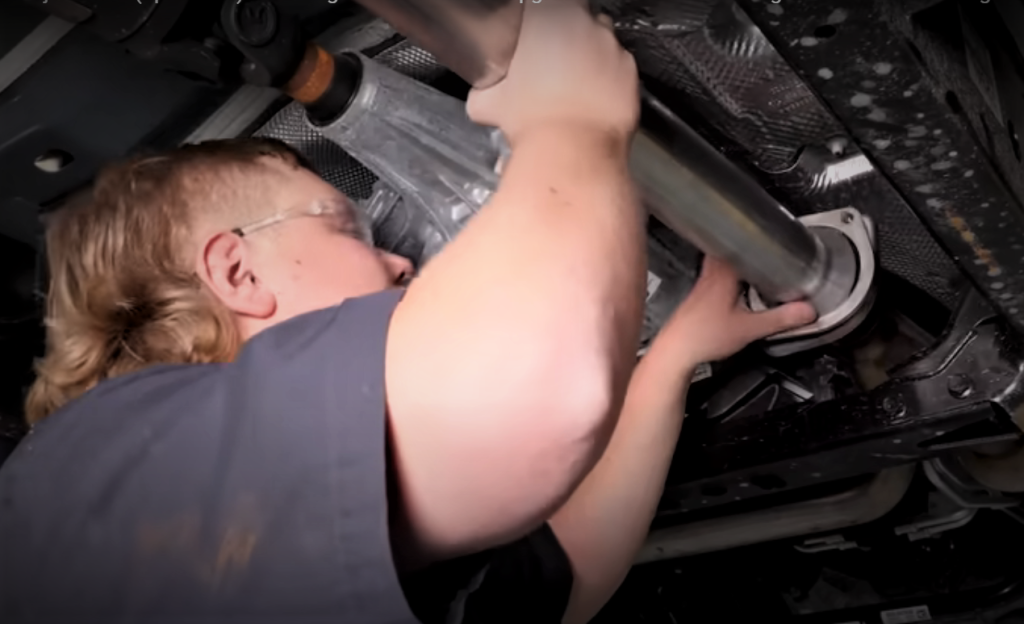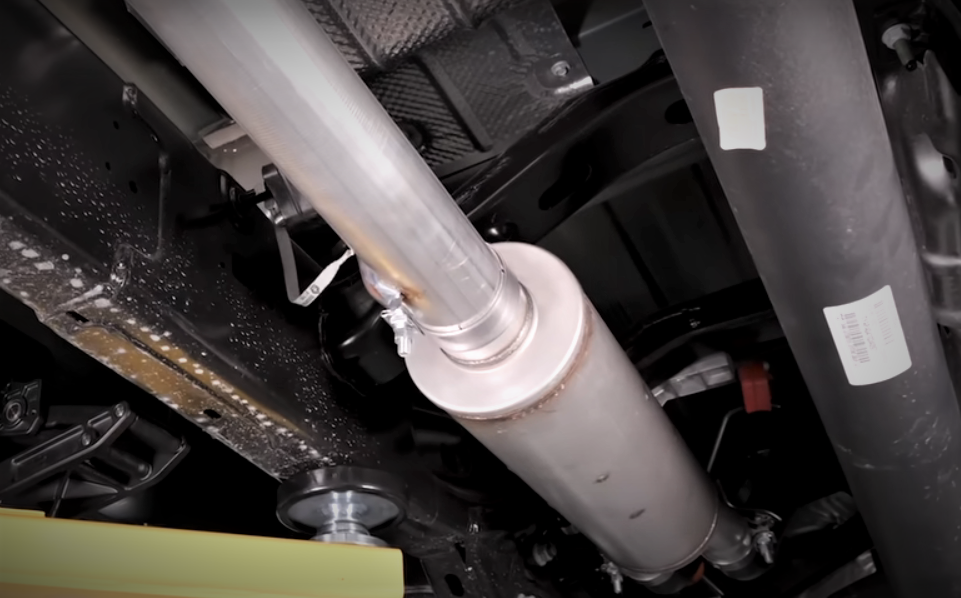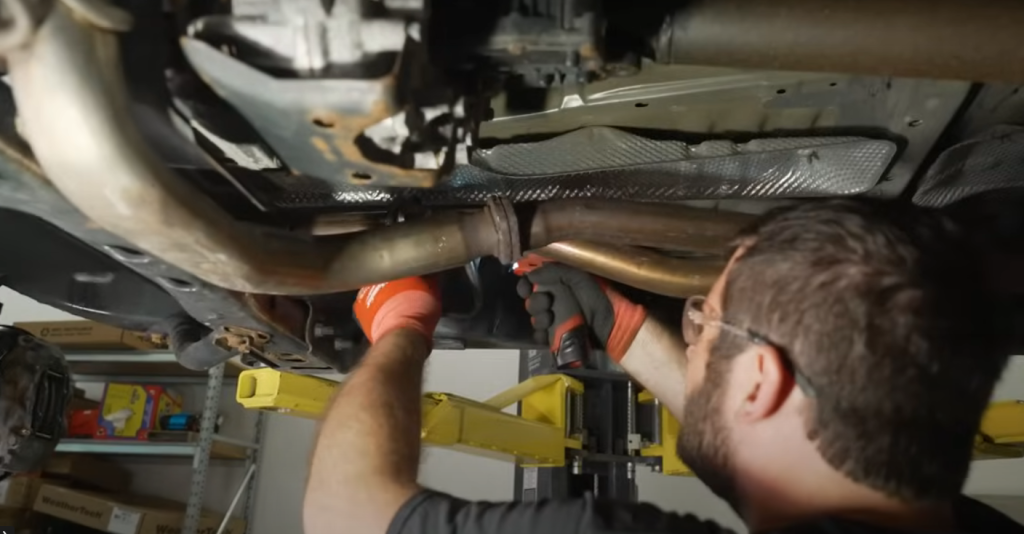Not too long ago, you were lucky if your car, truck, or SUV’s factory exhaust system made it past the vehicle warranty period. In fact, we have not-so-fond memories of replacing exhaust systems on vehicles that were just a few years old—a clear consequence of living in a region where the DOT uses salt in the winter to clear the roads.
That started to change during the 1990s though, as vehicle manufacturers began making exhaust systems out of aluminized steel and stainless steel so they would last through ever-longer vehicle warranty periods. Today, most OEM exhaust systems are made from stainless steel.
But! That doesn’t mean a factory exhaust system will last forever. If you’re the type that keeps a vehicle for a long time, you’ll eventually have to replace at least part of your exhaust system. Don’t let that scare you though, because exhaust systems aren’t really that tough to install.
The better news? It’s easier than ever to find the best exhaust system for your ride, whether you want a direct OE-style replacement or an aftermarket performance exhaust upgrade. It’s also simple to get individual exhaust parts like hangers, mufflers, and catalytic converters, and tools to make the job go a little smoother.

How to Tell If Your Exhaust System is Going Bad
A good factory stainless steel exhaust system should last at least five years of daily driving, and that timeframe increases if you’re in a dry climate. But rust and road debris are always busy attacking your pipes. That’s why it’s a good idea to crouch down and inspect the system periodically.
Thankfully, a failing exhaust system usually isn’t subtle, and there are plenty of things to look for:
- Excessive movement
- Cracked welds at joints
- Cracks in the exhaust manifold(s)
- Pinholes or punctures in tubing or muffler(s)
- Split or open seams, especially on mufflers
- Loose heat shields
- Loose or broken clamps and brackets
- Missing bolts, clamps, or other parts
- Dents or other damage from road debris, hitting a curb, etc.
Other signs of an exhaust system going bad include a loss of power or an illuminated check engine light (both signs of a clogged catalytic converter); exhaust odor in the cabin; vibration under acceleration; and of course, rattles.
Some Words on Rust
Rust can attack an exhaust system from within, too. Those water drops you see at the tailpipe? That’s moisture that has condensed in the exhaust system when the vehicle was parked. If you frequently drive short distances, the exhaust system doesn’t get warm enough to burn off that moisture and it will start eating away at your pipes. Take a long drive once in a while to fully heat up the exhaust system and get rid of that moisture.
Comparing Pros & Cons of Exhaust System Materials

Replacement and performance exhaust systems are typically available in mild steel, aluminized steel, or stainless steel. Here are the pros and cons of some of the more common construction materials:
- Mild steel systems are strong and budget-friendly, but are very susceptible to rust. They are a good choice for a vehicle that you don’t plan on keeping for a long time or won’t see daily use.
- Aluminized steel systems are made from mild steel coated with an aluminum-silicone alloy to help resist corrosion. If the coating is scratched or damaged, the metal underneath will rust. Welded joints and seams will also rust since they don’t have the aluminized coating. Aluminized systems are affordable, and can endure several years of daily driving, depending on the climate where the vehicle is driven.
- Stainless steel systems are the most expensive, and for good reason. They can handle high exhaust temperatures (common on vehicles with catalytic converters and turbos) and are very corrosion-resistant. Exhaust pipes made from stainless are also thinner than ones made from mild steel, which can save some weight.
Understanding the Different Grades of Stainless Steel in an Exhaust System
If you go the stainless route, those exhaust components are usually made from one of two grades of stainless steel.
- 409 stainless steel is what the OEMs and most aftermarket exhaust manufacturers use. It is far more corrosion-resistant than steel or aluminized steel, but will develop surface rust over time that won’t affect durability. A 409 stainless steel system has a life expectancy of eight to 10 years of daily driving.
- 304 stainless steel contains more chromium and nickel than 409 stainless. It won’t develop any surface rust, but will turn golden brown over time unless you polish it. 304 stainless steel also resists higher temperatures than 409 stainless, making it an excellent choice for high performance vehicles, especially ones with turbochargers that generate a lot of exhaust heat. Of course, 304 stainless steel systems are more expensive, but can last 10 years or longer.
Replacing Your Catalytic Converter
Let’s dispel a popular myth: Catalytic converters don’t cost you horsepower.
Now sure, that wasn’t always the case back in the 1970s. Those early catalytic converters used a pellet-catalyst design that really choked exhaust flow. But nowadays, converters have a monolithic/honeycomb catalyst design that poses little restriction to exhaust flow, so you can have your horsepower cake and reduce emissions, too.
Since they’re considered part of the vehicle’s emissions system, converters are designed to last a long time; the current U.S. EPA requirement is eight years/80,000 miles. But like any other part, converters can go wrong.*
*And since they are mandated by the government, there’s a good chance that it’s illegal to tamper with, modify, or remove your catalytic converter where you live. Check with your local laws and regulations before you start any exhaust system service.

The two most common ways a catalytic converter can fail are catalyst meltdown and poisoning.
Meltdown occurs when unburned fuel and oxygen enter the converter and combust. If your converter is glowing red from heat, that’s the reason. Left unchecked, the catalyst brick(s) will melt into a solid mass and block exhaust flow. Other than the glow, the main symptom of a melted converter is sluggish performance.
Catalyst poisoning occurs when the converter is exposed to substances that coat the catalyst to the point it cannot properly function. Causes include:
- Excessive carbon buildup in the exhaust
- Internal coolant leaks
- Use of non-converter-safe gasket sealants
- Excessive oil consumption/burning oil
- Improper fuels or additives
If your catalytic converter has failed, several companies make OEM replacement and universal-fit catalytic converters—including folks like Walker, AP Exhaust, and Bosal. The universal-fit converters flow far better than old bead-style converters, making them ideal replacements for older vehicles that came with a converter from the factory.
Some late model vehicles also feature converters that are built right into the exhaust manifold. If that’s what you’ve got, you can find those manifold-style converters from manufacturers like Pacesetter, Dorman, AP Exhaust, and Magnaflow. Common on modern cars and trucks nowadays, the design combines the exhaust manifold and a converter into one unit. That allows the converter to heat up very quickly so it oxidizes pollutants at startup when the when the air/fuel mixture is richest.
Other Essential Exhaust System Replacement Parts You May Need
There’s a lot more to an exhaust system than just big metal tubes, of course. So here’s a list of other, often-overlooked components you should check and repair/replace when you’re installing a new exhaust system:
- Exhaust manifold(s)
- Exhaust manifold & flange gaskets
- Oxygen sensor(s)
- AIR pumps
- Hangers & insulators
- Clamps
Important Exhaust System Repair & Installation Tools

If you’ve never tackled any exhaust work before, there’s a good chance you’ll need to pickup a modest assortment of tools to ensure the job goes smoothly. The good news here is that these tools often come in handy for a variety of other jobs too.
Depending on the condition of your current exhaust system, you may need some specialty tools to remove stubborn bolts, brackets, and fittings:
- Grinder
- Reciprocating saw
- Pry bars
- Breaker bar
- Plenty(!) of penetrating spray
There are some more advanced job-specific exhaust service tools that may help your exhaust replacement as well:
- An exhaust manifold spreader expands a manifold or header so you can properly align the bolt holes and prevent the bolts or studs from cross-threading when you tighten them
- Exhaust pipe end shapers help reshape bent, crushed, or flared pipes. Insert the point of the shaper cone into the pipe to round it out, or place the big end over the pipe to reshape flares
- Exhaust hanger pliers make short work of separating rubber hangers from their brackets
- A stud remover tool is designed to grab and hold broken exhaust manifold studs for easier removal. It also works on studs in blocks, cylinder heads, and other engine components
Other Vehicle Exhaust Replacement Articles, Tips & Resources
Here are a few more articles for you to peruse before tackling your first DIY automotive exhaust service. And if you’re an experienced wrencher and want to offer your own advice and insight, let us know in the comments section below.

Comments